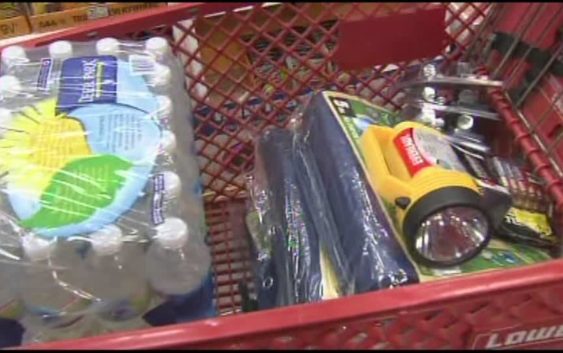- Governor Cooper to reveal crucial disaster recovery plan for Hurricane Helene relief Wednesday
- Active-duty military winding down Hurricane Helene recovery mission in western North Carolina
- Right-wing political activists call for NC lawmakers to decide 2024 presidential election results after Hurricane Helene's impact
- Grove Park Inn cancels National Gingerbread House Competition for 2024 due to Hurricane Helene devastation
- Trump makes more debunked claims about FEMA as he surveys storm damage in North Carolina
What should I do when a hurricane approaches?

Putting together a hurricane “survival kit”? Here are three-day and 14-day checklists of items you’ll want to include.
Be sure to check out the WRAL video of some items you might not be aware you will need if you’re without food, clean water or electricity.
Three-day supply kit
Start with an easy to carry, watertight container – a large, plastic trash can will do, or you can line a sturdy cardboard box with a couple of trash bags. Next, gather the following items and place them in your kit:
- Water: 1 gallon per person per day. Fill plastic containers, such as soft-drink bottles.
- Water purification kit or bleach (use eight drops of regular bleach per gallon of water.
- Essential medications
- First-aid book and kit that includes:
– 20 emergency bandages of various sizes
– One 5 x 9 sterile dressing
– One roll of self-adhering elastic bandage
– Four various-sized sterile gauze pads
– One roll of 3-inch cohesive bandage
– Waterless alcohol-based sanitizer and wipes
– Medical grade non-latex gloves
– Adhesive tape, 2-inch width
– Anti-bacterial ointment
– Cold pack
– Small scissors
– Tweezers
– CPR breathing barrier, such as a face shield
– Non-prescription drugs (e.g., aspirin or non-aspirin pain relievers)
- Ready-to-eat, non-perishable foods, such as canned meats, granola bars, instant soup and cereals, fruits and vegetables, canned or box juices, peanut butter, jelly, crackers, granola bars, trail mix, bread and any special dietary items you and your family need.
-
Manual can opener
- Baby supplies: formula, bottle, pacifier, soap, baby powder, clothing, blankets, baby wipes, disposable diapers, canned food and juices
- Food, water, leash and carrier for pets (If you plan to go to a shelter, remember that most do not allow pets. Make other plans for your pets.)
- Sanitary Items:
– Large, plastic trash bags for waste and to use as tarps and rain ponchos
– Large trash cans
– Towelettes
– Bar soap and liquid detergent
– Shampoo
– Toothpaste and toothbrushes
– Feminine hygiene supplies
– Toilet paper
– Household bleach for cleaning
– Rubber gloves
- Blanket or sleeping bag per person
- Battery-powered, portable radio or portable TV and plenty of extra batteries
- Flashlight and extra batteries
- Extra pair of eyeglasses
- Extra house and car keys
- Fire extinguisher (ABC-type)
- Cash and change
- Seasonal change of clothing, including sturdy shoes
Prepare your paperwork
Start with a portable, waterproof (airtight) bag that’s brightly colored, so you can quickly find it in the dark. Diving equipment shops stock the ideal bag, but gallon-sized or larger zip-lock bags will do in a pinch.
Print this checklist and keep it inside your waterproof bag to help you collect the items listed below:
- Driver’s license, photo ID
- Emergency contact list or address book (even if contacts are stored in a smartphone)
- Insurance policies (health, home, auto)
- Vital documents (birth certificates, passports, wills)
- Bank account information (account numbers, passwords)
- Photocopies of credit and debit cards (front and back)
- Stock certificates, investment information
- Extra keys (home, safe deposit box, office and car)
Remember: When packing, be realistic about what you can carry. Pack only what is essential for surviving the storm and its aftermath.
Don’t forget to hurricane-proof your digital information. Backing up to a portable hard drive leaves you open to the same storm-related dangers your computer faces. Cloud-based backup preserves your data and grants you secure access from anywhere.
Finally, create an emergency kit with necessities for your pets, including food, water, and medicines, as well as a collar and leash.
14-day supply kit
The experiences of Hurricanes Hugo, Bertha and Fran have taught North Carolinians to be prepared to live without utilities and basic services for two weeks or more. In addition to the three-day supply kit, these supplies will be good to have if you find your self going 14 days without electricity or running water:
- Disposable plates, cups, utensils
- Plastic garbage bags
- Mosquito repellent
- Cooler
- Ice
- Toiletries
- Detergent for dishes and clothes
- Clothesline and clothespins
- Games, such as cards, and quiet toys
- Duct and masking tape
- Rolls of plastic
- Lantern and fuel (not candles)
- Gloves and goggles
- Small tools
- Cleaning supplies
- Brooms and mops
- Pails and buckets
- Ladders
- Plywood and nails
- Rakes and shovels
- Chain saw, gas and oil
- Wheelbarrow
- Battery-operated clock
- Butane lighter or matches
- Axes, hatchets, pruners
- Rope